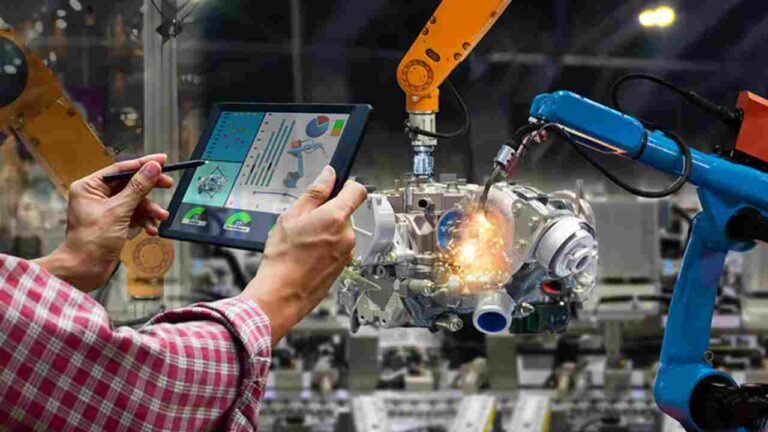1. Robotic Surgery: Precision and Minimally Invasive Procedures
One of the most significant advancements robotics has brought to healthcare is robotic surgery. With systems like the da Vinci Surgical System, surgeons can perform highly precise procedures with minimal incisions, reducing patient recovery times and improving outcomes. Robotic surgery allows for greater dexterity and flexibility, enabling complex operations to be performed with high precision.
Key Features:
- Minimally invasive surgeries with smaller incisions
- Enhanced precision and reduced human error
- Faster recovery times and less post-surgery pain
- Remote surgery capabilities for telemedicine
2. Robotics in Rehabilitation: Helping Patients Recover Faster
Robots are also playing a key role in patient rehabilitation. Robotic exoskeletons and robotic-assisted physiotherapy devices help patients regain mobility and strength, especially those recovering from spinal cord injuries, strokes, or other debilitating conditions. These devices are designed to assist with movement therapy, enhancing recovery by offering consistent and targeted physical assistance.
Key Features:
- Assistance with mobility and rehabilitation
- Targeted physical therapy for faster recovery
- Increased patient independence and motivation
- Personalization of rehabilitation programs
3. Robotic Prosthetics: Restoring Independence to Amputees
Advancements in robotic prosthetics have significantly improved the quality of life for amputees. These high-tech devices, powered by robotics and AI, allow users to control prosthetic limbs with much more precision and fluidity. With innovations in bionic arms and robotic legs, patients can now perform everyday tasks more naturally and with enhanced mobility.
Key Features:
- AI-powered, lifelike prosthetic limbs
- Real-time adjustments for better control
- Restores greater independence to amputees
- Integration with user brain signals for advanced control
4. Robotics in Diagnostics: AI-Powered Imaging and Analysis
Robots are revolutionizing diagnostic tools in healthcare. AI-powered robotic systems are now able to conduct diagnostic imaging more efficiently and accurately. For instance, robotic microscopes and imaging systems can scan tissue samples, detect abnormalities, and provide faster results than traditional methods, enabling early detection of diseases like cancer, heart conditions, and neurological disorders.
Key Features:
- Advanced imaging and diagnostic analysis
- Faster and more accurate diagnostic results
- Early detection of diseases like cancer
- Integration with AI to analyze complex data
5. Surgical Assistance Robots: Enhancing Surgeons’ Capabilities
While robotic surgery systems like da Vinci allow for full surgical procedures, there are also robots designed to assist surgeons during complex operations. These robots hold tools or instruments steady, provide additional lighting, or help in minimally invasive surgery by offering enhanced visualization. Robot-assisted surgeries have made procedures more accurate and less risky, offering surgeons the ability to focus on more critical aspects of surgery.
Key Features:
- Provides assistance during surgery for enhanced precision
- Real-time feedback and tool guidance
- Minimizes human errors in critical procedures
- Enhanced visualization for complex surgeries
6. Robotics in Elderly Care: Improving Quality of Life
With an aging global population, robots are becoming invaluable in elderly care. Robots designed for aging-in-place solutions help older adults live independently while offering assistance with daily tasks, mobility, and health monitoring. For example, robots like Paro (a therapeutic robot) and TUG (a delivery robot in hospitals) help maintain emotional well-being and support hospital staff with logistics.
Key Features:
- Assistance with daily activities like medication management
- Robotic companions for emotional and mental support
- Monitoring of vital signs and health status
- Enhanced independence for elderly patients
7. Robotic Pharmacies: Revolutionizing Drug Dispensing
Robotics is also transforming how medicines are dispensed in hospitals and pharmacies. Automated robotic pharmacies can store, manage, and distribute medications with incredible efficiency, reducing human errors in drug dispensing. These systems allow for faster processing times and ensure the accurate distribution of the right medication to the right patients.
Key Features:
- Automated drug storage and dispensing
- Reduced human error in medication administration
- Increased efficiency and faster service in hospitals and pharmacies
- Real-time inventory management
8. Robotics in Hospital Logistics: Enhancing Efficiency
Robotics is playing a significant role in improving hospital logistics. Robots like TUG robots are used to transport medications, supplies, and linens throughout hospitals. These autonomous robots navigate through hospital hallways, reducing the need for staff to perform repetitive and time-consuming tasks, allowing them to focus more on patient care.
Key Features:
- Autonomous transport of medical supplies
- Improved hospital efficiency and workflow
- Reduced staff workload and enhanced focus on patient care
- Increased hospital operational efficiency
9. Robotics and AI in Personalized Medicine: Customizing Treatments
The combination of robotics and AI is advancing personalized medicine, enabling tailored treatments based on patient-specific data. Robots can assist in developing personalized treatment plans, analyze large datasets for optimal therapy suggestions, and perform specialized procedures that are customized to each patient’s genetic makeup. This makes medical care more targeted, improving outcomes and reducing side effects.
Key Features:
- AI and robotics-powered personalized treatment plans
- Analysis of genetic data for optimized therapies
- Tailored medical procedures and therapies
- Improved treatment efficacy and reduced adverse effects
10. The Future of Robotics in Healthcare: AI and Beyond
The future of robotics in healthcare is bright, with new advancements emerging daily. In the coming years, AI integration with robotics will offer even more advanced capabilities, such as autonomous robots that can perform surgeries without human intervention, robots capable of emotional intelligence for improved patient care, and AI-powered diagnostics that can predict diseases long before symptoms appear.
Key Features:
- Autonomous robotic surgeries and procedures
- Robots with AI-driven emotional intelligence
- Predictive healthcare using AI and robotics
- Integration with wearable health tech for real-time monitoring
Conclusion
Robotics is transforming healthcare by improving precision, increasing efficiency, and enhancing patient care. From surgical assistance to rehabilitation, robots are becoming integral to modern healthcare practices, offering a new level of automation, precision, and personalized treatment. As technology continues to evolve, the role of robotics in healthcare will only grow, promising a future where patient care is more efficient, accurate, and accessible than ever before.

